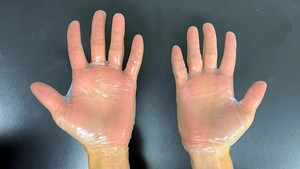THE ASAHI SHIMBUN
July 1, 2019 at 18:35 JST
Under the watchful eye of the world's media, fishermen hunting for whales sailed from Japanese ports on July 1 amid hopes and concerns from the public, as Japan revived commercial whaling for the first time in 31 years.
Japan's withdrawal from the International Whaling Commission became official the day before, setting it on course to resume commercial whaling in waters in the country’s exclusive economic zone.
The Fisheries Agency announced on July 1 that the number of whales that Japan can harvest annually through commercial whaling is 383.
In Shimonoseki, Yamaguchi Prefecture, in western Japan, a group of three ships, including mother ship the Nisshin Maru, departed from the port in the morning for offshore hunting. A total of 100 fishermen were aboard the vessels.
In a departure ceremony, fisheries minister Takamori Yoshikawa addressed the crew members.
“I am hoping many members of the public will consume whale meat so that the whaling industry will be sustained,” he said.
In Kushiro in the northernmost main island of Hokkaido, a fleet of five small ships from across Japan set off from the port together to hunt for whales in waters close to the Japanese coast in a day trip.
Journalists from foreign news outlets, such as CNN in the United States and AFP in France, were on hand to cover the whaling ships’ departure.
Apart from concerns about the business viability, Japan will have to deal with international criticism of commercial whaling.
No big protests were staged by anti-whaling groups on July 1, according to the Fisheries Agency.
SHIMONOSEKI FAMED FOR WHALE MEAT
Shimonoseki has been known as a leading distribution hub for whale meat since the Edo Period (1603-1867). What is now Maruha Nichiro Corp., a Tokyo-based major food company, was headquartered in the city before World War II, engaging in large-scale whale hunting.
Whale meat was treasured as a vital protein source when Japan was in a severe food shortage after the war’s end. Shimonoseki thrived with factories processing whale meat and restaurants serving dishes offering it.
But the bustling port city lost steam when Japan suspended commercial whale hunting in 1988 in the face of growing international criticism over the practice.
Still, Shimonoseki played host to vessels that continued hunting the sea mammals in the Antarctic Ocean and in the high seas in the northern Pacific under what Japan called its “scientific” whaling program.
Many in the city were eager to see commercial whaling revived. Junko Kojima, manager of a restaurant dedicated to whale meat dishes, is one of them.
“Whale meat is a sustainable marine resource for Japan whose food self-sufficiency ratio is low,” she said.
Mayor Shintaro Maeda hailed the return of commercial whaling, calling it a “milestone in the history of Shimonoseki.”
But not all Shimonoseki residents were delighted.
“Japanese are faced with a question whether they are serious about maintaining a whale meat eating culture,” said Hajime Ishikawa, 59, a member of nonprofit Whale Laboratory in the city. Ishikawa was formerly involved in scientific whaling program as leader of a hunting team.
Kushiro port in Hokkaido boasted the nation’s largest catch of whales in coastal whaling from 1952 to 1961. It regained the status of a whaling port for the government's research whaling program in 2002.
In Kushiro, a manager of a restaurant serving whale meat dishes welcomed the revival of commercial hunting, describing it as “soul food.”
“There are countries that do not allow catching whales for consumption, but whale meat may be back on the dinner table once a food crisis occurs,” the restaurant manager said.
WHALE MEAT CONSUMPTION NEAR ZERO
Annual consumption of whale meat peaked in Japan in 1962, at 2.4 kilograms per person, double the amount of beef and chicken, according to data of the Ministry of Agriculture, Forestry and Fisheries.
But the figure has been hovering at close to zero since 1987.
Japan defined meat from whales caught under research whaling as a “by-product” of its scientific study of the mammal’s biology.
Whale meat was traded after the Institute of Cetacean Research and other entities that conducted research whaling set the price.
But as Japan resumes commercial whaling, the market will determine the price, depending on consumer demand.
QUOTA FOR COMMERCIAL HUNT
A Fisheries Agency official noted that criticism from the global community of Japan's resumption of commercial hunting played a part in setting the annual harvest quota.
“We arrived at the number as the one that would not deplete the whale population even after hunting the animals for 100 years,” the official said.
The number of 383 is significantly lower than last year’s catch of 637 conducted under the name of research whaling.
The allotted species targeted in commercial hunting are 171 mink whales, 25 sei whales and 187 Bryde’s whales.
By year-end, fishermen can harvest 227 of the three species. The agency set the number after the figure for whales caught under research whaling through June was subtracted from the target of 383.
Japan announced its decision to withdraw from the IWC in December 2018 after its proposal for resuming commercial whaling was voted down earlier that year.




















Stories about memories of cherry blossoms solicited from readers
Cooking experts, chefs and others involved in the field of food introduce their special recipes intertwined with their paths in life.
A series based on diplomatic documents declassified by Japan’s Foreign Ministry
A series on the death of a Japanese woman that sparked a debate about criminal justice policy in the United States
A series about Japanese-Americans and their memories of World War II
Here is a collection of first-hand accounts by “hibakusha” atomic bomb survivors.